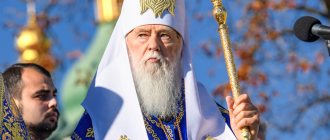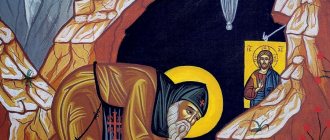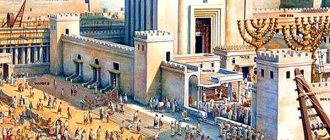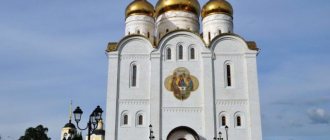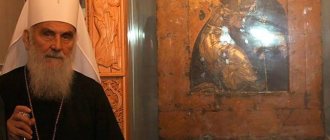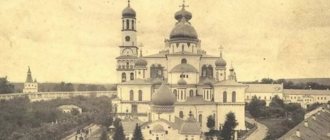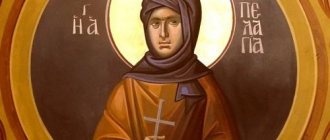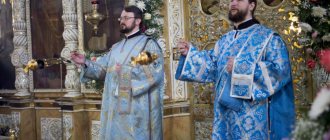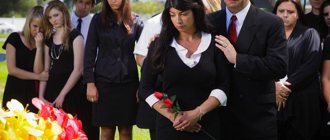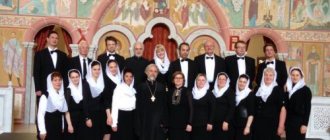The Jerusalem Orthodox Church is one of the oldest autocephalous local Orthodox churches, occupying fourth place in the diptych of primates of Orthodox churches.
This means that the Jerusalem Patriarchate is exalted in fourth place, compared to other patriarchates.
Autocephaly is the status of a local church. An autocephalous church can be headed by a bishop, who has the title of patriarch or metropolitan.
A diptych is a list of names used during worship services.
Church of Mary Magdalene in Jerusalem
From history we learn that Jerusalem was founded by the high priest Melchizedek
The history of this holy place is very rich. According to legend, the city of Jerusalem was founded by the high priest and king Melchizedek, who brought here the body of the first man, the forefather Adam, and buried him on Mount Golgotha.
Meeting of the High Priest of Jerusalem Melchizedek and Abraham. It was he who buried Abraham on Mount Golgotha
In 1004 BC, King David made Jerusalem the center of the Israeli state. At the end of the 11th - beginning of the 10th centuries, the city was fully formed and became the greatest architectural structure of that time.
7 wonders
Solomon's Temple is one of the wonders of the world
This is confirmed by at least the mention of the beauty and splendor of the Jerusalem Temple built by Solomon, which was rightfully considered his greatest work.
Solomon's Temple was called in ancient times one of the 7 wonders of the world. It amazed eyewitnesses with its grandeur and enormous size.
This is what the first temple or Solomon's temple looked like in Jerusalem
Primates
[4]
- sschmch. ap. James, brother of the Lord (+ c. 63)
- sschmch. ap. Simeon, son of Cleopas (+ 106/107)
- Just (106/108 - 110/113)
- St. Zacchaeus (early 2nd century)
- Tobiah
- Benjamin I
- Joachim I
- John I
- St. Matthias
- Benjamin II, called Philip
- Seneca
- Just II
- Levi
- St. Ephraim I
- Joseph I
- Judas Cyriacus (? - 134/135)
- sschmch. Mark I (134/135 - 156)
- Cassian
- Puvliy
- Maxim I
- Iuliy or Iulian
- Gaius I (c. 160 - 163)
- Symmachus
- Gaius II (c. 165-168)
- Julian or Ualis
- Kapiton
- Maxim II
- Antonin
- Ualis
- Dolikhian (? - 185)
- sschmch. Narcissus (185/197 - approx. 212) [5]
- Diy (211)
- Germanium (211)
- Gordius (211)
- sschmch. Alexander (213 - 251)
- Mazavan (251 - 260)
- Name (260 - 298)
- Zavda (298 - 300)
- Hermon (300 - 312/314)
- St. Macarius I (312/314 - 333/334)
- St. Maxim III (333/334 - 348)
- St. Cyril I (350 - 386)
- St. John II (386 - 417)
- Rule (417 - 422)
- St. Juvenal (c. 422 - c. 458) in 449-451 - Monophysite
- Theodosius, false patriarch-monophysite (452 - 453)
- Gabriel Vrula
(c. 1309)
- Damian (Casatos) (February - July 1897) locum tenens, archbishop. Philadelphian
- Keladion (August 14, 1931 - October 1, 1934) locum tenens, metropolitan. Ptolemaidan
- Meliton (October 1, 1934 - July 22, 1935) locum tenens, metropolitan. Madavonsky
- Athenagoras (Vasiliadis) (1955 - 1957) locum tenens, metropolitan. Sevastian
- German (Mamaladis) (1980 – 1981) locum tenens, metropolitan. Petrsky
- Cornilius (Rodusakis) (December 20, 2000 - August 13, 2001) locum tenens, metropolitan. Petrsky
- Cornelius (Rodusakis) (May 30 - August 22, 2005) locum tenens, metropolitan. Petrsky
At one time, Jerusalem suffered a lot of troubles - it was captured many times
This city suffered many troubles and sorrows: it was captured by the Assyrians, Babylonians, and Romans. They destroyed and rebuilt again, and destroyed again.
But by the great grace of God, this particular city not only survived, but became the cradle of all Christianity and the mother of all Orthodox Churches.
After the ascension of our Lord Jesus Christ into heaven, his disciples, the holy apostles, convened a council in Jerusalem in 51, which became an important event in the life of the entire Christian world.
At the Council of Jerusalem, Christians decided to abandon many ritual rituals.
At this council, Christians renounced the need to observe Old Testament circumcision, animal sacrifices in the Jerusalem Temple, as well as many ritual rituals introduced by the scribes and Pharisees into the religious life of the Jews, for their blind adherence to which Christ himself denounced the scribes and Pharisees.
The Jerusalem community gave the world its first martyrs - Archdeacon Stephen and Apostle James.
The first 2 martyrs in Christianity accepted by the Jerusalem community - Stephen and James
After being elected by the Lord Himself to the apostolic ministry, Saul, who became Paul, went to Jerusalem to receive approval for his preaching from the first Christian Church.
Many members of the Jerusalem community became the first Christian missionaries, preaching the Gospel of the Kingdom to those near and far, to Jew and Gentile.
Notes[edit | edit code]
- According to other sources - about 150,000
- Christian Arabs
// Orthodox Encyclopedia, Vol. 3, p. 155 [1] - Archimandrite Philumen
- Orthodoxy in Palestine today (TV program 03.28.09)
- Christians of Palestine: strangers among their own (commentary in the light of faith)
- Persecution of Christians continues in the Palestinian Authority // Sedmitsa.ru, 09/12/2006
- The Jerusalem Patriarchate has created a commission to assist Russian-speaking parishes in Israel. NEWSru.com April 11, 2008
- See, for example, the article Shulchan Aruch
- An Orthodox church was destroyed in Migdal HaEmeke
- Alex Maistrovoy
“Christian Exodus” - there
- https://www.mospat.ru/archive/10090-1.html
- Greece demands that Israel immediately recognize the Patriarch of Jerusalem. NEWSru.com July 3, 2007
- The data may be out of date and need to be rechecked
- Notes of the Kyiv Theological Academy and Seminary. History of Local Orthodox Churches
The first bishop of the Jerusalem Church is the holy Apostle James
The first bishop of the Jerusalem Church was the holy Apostle James, the Lord's brother in the flesh.
James is one of the 70 apostles of Christ and the first bishop in the Jerusalem Church
He also testified his fidelity to Christ by martyrdom.
At the height of the first Jewish war, which took place from 66 to 73, the city was sacked by the troops of the Roman emperor Titus Flavius.
70
King Solomon's Temple was destroyed this year
In the year 70, that very magnificent temple of King Solomon was destroyed. Later, several decades later, the wicked emperor Hadrian built a pagan temple on this site in honor of the idol of Jupiter and the temple of Venus.
The city itself was renamed Aelia Capitolina. The indigenous inhabitants could not tolerate such blasphemy and moved to the land beyond the Jordan River, and thus the Christian primitive community of Jerusalem actually ceased to exist.
Over time, a new Church was formed in Aelia Capitolina, and its governing bishop, almost until the middle of the 5th century, was canonically subordinate to the Metropolitan of Caesarea in Palestine, that is, the canonical Antiochian Orthodox Church.
The situation of Orthodox Christians in the Palestinian Authority[edit | edit code]
Church of the Nativity in Bethlehem
Currently, the Orthodox community (as well as the Christian community in general) in Palestine is shrinking and its situation is quite complex and difficult. In a way, the Christian community has found itself between two fires: on the one hand, it is forced to bear all the burdens associated with the Arab-Israeli conflict and the Israeli occupation, on the other hand, it is also experiencing pressure from Muslim radicalists.
The Israeli occupation, the disastrous economic situation caused by the blockade of the “territories” and especially the construction of the “security wall”, led to the fact that Christians began to leave the Palestinian cities in which they had lived for generations and move to the West[4].
Also, Christians often become targets of aggression from Muslim extremist groups. There were repeated attacks on churches. The targets of Islamist attacks are often not only churches, but also Christian homes. Thus, in 2005, at least 14 houses of Christians - Orthodox and Catholics were burned by fanatical Muslims in the village of Taiba. According to the residents of the affected village, early in the morning several dozen young Muslims from Dir Jarir threw Molotov cocktails at the houses of the "infidels", after which they began destroy cars parked nearby and beat up residents. In addition to houses with the property of their residents, a gas station, several shops and an agricultural farm burned down. The police team that was called was not able to arrive at the scene on time. The Israeli police not only did not stop the bandits themselves, but also detained a Palestinian police squad heading to Taibah.[5] Local authorities are in no hurry to defend the law if it is violated in relation to Christians. Hamas does not hesitate to dictate its position through the Islamic clergy. Local imams call for the extermination of Christians during Friday prayers[6].
The Holy Land of Jerusalem begins to be reborn over time - around the 4th century
The revival of Jerusalem began in the 4th century thanks to the activities of Emperor Constantine the Great and his mother Queen Helena, who not only returned the city to its real name and built many temples associated with the earthly life of the Savior.
325
this year the First Ecumenical Council of Nicaea recognized the rights of the regional metropolitan for the Bishop of Jerusalem
It was from this time that the city of Jerusalem and the entire Holy Land became a place of pilgrimage for Orthodox Christians from all over the globe.
The following year, 326, the monastery of the Holy Sepulcher was established, the inhabitants of which were the Holy Sepulcher Brotherhood, which zealously defended the Christian shrines entrusted to it.
The Fourth Ecumenical Council of 451 determined that the Bishop of the Holy City of Jerusalem in the diptych of Churches should occupy an honorable fifth place in the diptych of Orthodox hierarchs.
The Ecumenical Council assigned the bishop of the Holy City of Jerusalem the 5th place in the diptych of Churches.
At the same Council, the Primate of the Jerusalem Church was crowned with the title of Patriarch.
The Patriarchs of Jerusalem initially disputed the fifth place assigned to them, taking advantage of the authority of Jerusalem as the cradle of Christianity and the place of life of the Savior.
But due to political processes, Jerusalem as a city had virtually no noticeable influence on the life of Byzantium and was not even the center of the prefecture.
Land ownership and symbolism[ | ]
Tau-fi symbol.
Patriarchy flag with tau-fi symbol. The symbol of the church is a ligature of the Greek letters tau and , denoting the Greek word ταφος - coffin.
The Orthodox Church has extensive holdings in Jerusalem and throughout Israel and the Palestinian territories. In addition to numerous churches, seminaries and other sites used for religious purposes, church properties include the land on which the Knesset and the Prime Minister's residence are located, as well as many historic buildings in the Old City of Jerusalem, including the Imperial and Petra hotels inside Jaffa gate of the Old Town[11].
Orthodox monasteries in Jerusalem will soon begin to appear
At this time and in subsequent centuries, Palestine was one of the centers of development of Orthodox monasticism. One after another, Orthodox monasteries appeared in Jerusalem and its environs.
By the middle of the 5th century there were about ten thousand monks in the Jerusalem Church.
Soon the city faced a new test - in 614, the Persian Khan Khmmosroi attacked Jerusalem. Many Christians were killed, churches and monasteries were destroyed, valuables and shrines were looted. In particular, the Persians stole the Life-Giving Tree of the Holy Cross, which was returned in 628.
In 638, Jerusalem was conquered again, this time by the Arab caliph Omar. This began the period of Muslim rule, which had dire consequences for the Orthodox. The Arabic language is penetrating among Christians, and the population as a whole is also becoming Arabized.
638
this year Jerusalem was conquered again, this time by the Arab caliph Omar
But God did not abandon his people in these difficult times. It was the Jerusalem Church that produced saints, ascetics, theologians and hymns, among whom St. Sophronius, St. John of Damascus and Cosmas of Mayum, St. Michael Sincellus and his disciples Theodore and Theophanes stand out.
Saint Sophronius - with the help of this saint the Jerusalem Church grew
The end of the 11th century was marked by the era of Latin rule. The reason for this was the first crusade in 1099, the participants of which took Jerusalem.
The Latin Kingdom of Jerusalem arose on the territory of Palestine. The new government began to gradually replace local Orthodox bishops with Catholic clergy.
This continued until 1187, until Jerusalem came under the rule of the Egyptian Sultan Salah ad-Din, who preferred that the Patriarchal See of Jerusalem be occupied by an Orthodox hierarch.
1534
Patriarch of Jerusalem Dorotheos, an Arab by birth, dies this year
Over the next centuries, Palestine passed either into the hands of the Crusaders, or under the rule of the Armenian Patriarchate, or under the rule of the Mamluks, which ended with the capture of Jerusalem by the Ottomans at the beginning of the 16th century.
It is important to note that there is very little information on this historical period in the life of the Jerusalem Patriarchate, due to the scarcity of historical sources.
The Orthodox, not only in Jerusalem, but throughout the whole world, were under the rule of the Turks, who used the shrines of Christians as a kind of gold mine.
After the death of Patriarch Dorotheus, the department was occupied only by Greeks.
This tradition was started by Patriarch German.
During this period, the Jerusalem Church, despite ecclesiastical autocephaly, lived for a long time under strong Greek influence, although the believers and lower clergy spoke exclusively Arabic. This, of course, hampered the development of church life in Jerusalem.
Orthodoxy in Israel[edit | edit code]
Insulting inscriptions made by Jewish pogromists on the fence of the Church of St.
Nicholas in Migdal HaEmeke The situation of Orthodoxy in Israel is somewhat different, although far from rosy.
This is due to repatriation, mainly from former countries. THE USSR. Therefore, in the second half of the 20th century, especially starting from the 90s of the century, another so-called Russian-speaking community took shape in the Jerusalem Church. Basically, the members of this community are Jewish emigrants from the former USSR and Russia who converted to Orthodoxy, as well as non-Jewish members of repatriate families. Thanks to emigrants, Israel in modern history has become the only country in the Middle East where, despite all the difficulties, the Orthodox community has even increased in recent years, parish life has been revived in several parishes, and several new churches have been opened.
Since services in the churches of the Holy Land were traditionally held in Arabic and Greek, this caused quite obvious language problems for new members of the community, so recently in those parishes where there are a significant number of repatriates, services began to be held in Church Slavonic. In April 2008, Patriarch Theophilus announced that a special commission had been created to help Russian-speaking parishes in Israel[7]. Attempts are also being made to conduct services in Hebrew.
Despite the fact that freedom of religion is protected by law, there have been cases of harassment against Israelis who decide not to become Jews, but to be Christians. According to the clergy, such parishioners are often forced to visit churches secretly so that neighbors and acquaintances do not see them. In general, it should be noted that Judaism prescribes that Jews treat their fellow Christians with even greater hatred and malice than they treat Christians from the “goyim”[8].
Here are some examples that relations between Jews and Orthodox Christians are far from simple:
- In the Israeli city of Migdal HaEmeke in 2004, the Orthodox Church of St. was restored by local Israelis of the Orthodox faith (mostly immigrants from the former USSR). Nicholas, built in the 19th century, but then fell into disrepair because the local Arab residents were expelled in 1948 by Jewish invaders. However, when restoration work began on the church, problems arose with a group of representatives of the local Jewish religious community, led by Rabbi Grossman. For almost a year and a half, since the opening of the temple, threats were heard from the Jewish community, and there were attempts to physically interfere with the restoration of the temple. After the intervention of journalists, the situation somewhat returned to normal, but not for long. On the night of June 8, 2006, Jewish fanatics staged a real pogrom: they broke and smashed icons outside the church, and broke windows. No one was punished. The police released the rioters on the grounds that they were allegedly minors. According to the injured party, this statement was untrue[9][10].
- …”There was an incident in Beersheba when we, together with another priest, came to an elderly woman at her request to confess her. After confession, we went outside and were surrounded by a crowd of people. They shouted insults, threatened, and cursed us. But the police did not detain them, but... us. On charges of being a missionary. It was simply absurd. We came there solely at the request of a sick woman. We were kept in the police station for four hours and banned from appearing here for two weeks under threat of a fine of five thousand shekels. No one apologized, and the police themselves also did not apologize for the rudeness and slander. This amazed us, because it completely contradicts the laws of Israel on religions and freedom” (Priest Roman Raduan)[11]
There were already 6 metropolises under the jurisdiction of the Jerusalem Patriarchate
By that time, under the jurisdiction of the Jerusalem Patriarchate there were 6 metropolises, 7 archiepiscopal sees and 1 episcopal see. Many of these departments were nominal in nature and existed only on paper. The number of believers within the jurisdiction of Jerusalem numbered only about 400 hundred people.
400
such a number of believers were in the jurisdiction of Jerusalem
It was especially difficult for the Orthodox in Palestine during the so-called Greek liberation uprising, as a result of which the Turks imposed a huge tribute on everyone.
At the beginning of the 19th century, the Patriarchs of Jerusalem repeatedly turned to the Russian Holy Synod for financial assistance, thanks to whose donations 5 public schools were opened in Jerusalem and the debts of the Monastery of the Holy Sepulcher were repaid.
In 1845, Cyril II, one of the outstanding saints of that time, was elected Patriarch of Jerusalem, who resumed the construction of churches in Palestine, opened several public schools, the first theological school, and established a hospital and a printing house in Jerusalem.
At the initiative of the Russian Empire, the Russian Spiritual Mission was established at this time, which was called upon to support the devastated Jerusalem Church, strengthen Orthodoxy in Palestine and Syria, and also spiritually nourish Russian pilgrims who came to worship the Holy Places.
Russian missionaries built Orthodox Russian churches and monasteries in Hebron with the Oak of Mamre, in Ain-Karem, on the Olivet, in Jaffa.
Already at the end of the 20th century, there were about 15 dioceses in the patriarchate.
By the end of the 20th century, the Patriarchate of Jerusalem began to number about 15 dioceses, with a total number of believers of approximately 30 thousand people.
In 1948, by decision of the UN General Assembly, the Jewish state of Israel was established.
In 1989, the Jerusalem Metochion resumed its activities in Moscow.
In the spring of 1991, Patriarch Alexy II made a pilgrimage to the Holy Land.
In 1997, Alexy II participated in celebrations dedicated to the 150th anniversary of the establishment of the Mission in Jerusalem
The Jerusalem Church after the formation of the State of Israel[edit | edit code]
In 1948, after the withdrawal of British troops from Palestine, by decision of the UN the Holy Land was divided into Jordan and Israel, which became a new source of tension in this region. The conditions in which the ministry of the Jerusalem Church takes place have become very difficult: numerous Arab-Israeli conflicts, oppression by the new (Israeli) authorities, expulsion from their lands and murders of Palestinians by Jews have not spared Christian Arabs[2].
During the capture of Jerusalem in 1948, many Christian churches and monasteries were seriously damaged or completely destroyed, and were subjected to targeted shelling and bombing by Jews. On May 17, a bomb hit the Cathedral of Saints Constantine and Helen, and fragments from it damaged the nearby Church of the Holy Sepulchre. The shelling was carried out from the Benedictine monastery on Mount Zion, captured by the Zionists. The monasteries of St. Abraham and St. Spyridon, as well as churches of other faiths, were fired upon. Between 1949 and 1967, Jews captured and plundered many churches and monasteries and desecrated Christian cemeteries. During the 1967 war, Israeli soldiers desecrated the Church of the Holy Sepulchre, breaking into it with dogs. While inside it, they smoked and drank. The same thing happened in the Church of the Nativity in Bethlehem, which was also shelled by artillery.
On November 29, 1979, in Nablus (Samaria), the rector of the church of a small monastery at Jacob’s Well, Archimandrite Philumen, was brutally tortured. Shortly before the murder, a group of Jews demanded that he remove the cross and icons from Jacob's Well under the pretext that the symbols of Christianity prevented them from praying in this sacred place for them. He refused to do this, recalling that Jacob’s Well was and remains an Orthodox shrine for many hundreds of years. In response, a death threat was made, which was soon carried out. On November 29, during an exceptionally heavy downpour, the killers broke into the monastery. They inflicted o. With an ax to Philumen's face, two cruciform wounds - from top to bottom and from ear to ear - gouged out his eyes and cut off in parts the fingers of his right hand, which form the sign of the Cross. Murder seemed not enough to them; they desecrated the church and staged a pogrom in it[3].
Church of the Holy Sepulcher - is now very well known to many Orthodox Christians
The main cathedral Church of the Resurrection of Christ is better known in the Orthodox world as the Church of the Holy Sepulcher.
The temple stands on holy ground: it was here, according to the Holy Scriptures of the New Testament, that the events of the crucifixion, burial and resurrection of our Lord Jesus Christ took place
It is in it, every year on the eve of Holy Easter, during the festive service on Holy Saturday, that the Holy Fire descends, the removal of which from the Holy Sepulcher symbolizes the resurrected Jesus Christ himself.
During the descent of the Holy Fire, an incredible number of people gather in the Church of the Holy Sepulcher
History[edit | edit code]
Main article
:
The Birth of Christianity in Palestine
Main article
:
History of the Jerusalem Orthodox Church
The Church of Jerusalem is called the Mother of all Christian Churches, since it was here that great events took place that became the center of human history: the birth, preaching, crucifixion and resurrection of the God-man Jesus Christ. In Jerusalem, the descent of the Holy Spirit took place on the apostles, from here the apostles dispersed to preach around the world and Christianity began to spread. Such great historical events took place in the Holy City as the discovery of the Honorable and Life-Giving Cross of the Lord by the Holy Empress Helena, the construction by her and the Holy Emperor Constantine of many churches at the sites of Gospel events: on Golgotha, on the Holy Sepulcher, over the Bethlehem Cave, on the Mount of Olives, etc. .
Orthodox Jerusalem is an opportunity to touch the most intimate
A pilgrimage to Orthodox Jerusalem is, first of all, an opportunity to touch the most intimate, to plunge into the mystery of the origins of faith, to touch the great shrines of the Christian world.
The shrines of the Jerusalem Patriarchate are unique in that they are connected with the earthly life of Christ and are described in the Gospel - Bethlehem, Golgotha and the Holy Sepulcher in the Church of the Resurrection of Christ, Gethsemane, Nazareth, the Mount of Olives.
One of the important destinations of pilgrimage is Mount Sinai, on which, from the first centuries of Christianity, a monastery was founded, consecrated in the name of the Virgin Mary the Burning Bush.
This monastery houses the oldest library, which is considered second only to the Vatican Library in terms of the number of ancient manuscripts collected.
Jerusalem is a holy place for every believer, uniting Christians, Muslims and Jews.
This is a center for those who want to know everything about the events of the Holy Scriptures.
This is an alluring, unique city, imbued with great history and deep hope for all those who pray and are grateful to the Lord.
A city stunning in its beauty and divinity, to which you want to return again and again.
By leaving a comment, you accept the user agreement
Russian Orthodox Church
The Jerusalem Church is the cradle of Christianity, the mother of Christian Churches, the keeper of the treasures sacred to Christianity of the Holy Land, where Christ the Savior lived, taught and accomplished the work of redemption of the world.
The first bishop and organizer of the Jerusalem Church was, according to legend, the Apostle James, the brother of the Lord in the flesh (+ c. 63), who headed the Apostolic Council of 51 in Jerusalem.
The Jerusalem Church gave the world such saints as Archbishop Kirill of Jerusalem (+386); Patriarch Juvenal of Jerusalem (+ c. 458), leader of the III and IV Ecumenical Councils; Bishop of Maium Saint Cosmas (+ c. 787), hymnist who compiled canons for many great holidays and Holy Week; venerable founders of the Palestinian monasteries Chariton the Confessor (+ ca. 350), Euthymius the Great (+473), Savva the Sanctified (+532) and many others.
The greatest shrines of the Jerusalem Church are Calvary and the Holy Sepulcher in the Church of the Resurrection of Christ. The most famous monasteries are the Monastery of the Holy Sepulcher, Bethlehem - above the cave of the Nativity of Christ, John the Baptist - near the Jordan, at the site of the Baptism of the Lord, the Lavra of Saint Sava the Consecrated, in which the relics of the saint are kept.
The Russian Church and the Russian state made a great contribution to the development of the Jerusalem Church. In the middle of the 19th century, the Russian Spiritual Mission was founded in the Holy Land. Later, in 1882, the Orthodox Palestine Society was formed, renamed in 1889 the Imperial Orthodox Palestine Society. Through their labors, many churches, schools, and hospitals were built in the Holy Land. The Jerusalem Church also received significant spiritual and material support.
Canonical territory: Israel, Jordan and Palestine. An autonomous part of the Church of Jerusalem is the Archdiocese of Sinai with the monastery of the Holy Great Martyr Catherine on Mount Sinai (Primate: Damian, His Eminence Archbishop of Sinai, Paran and Raifa; the residence of the Primate is in Cairo).
The title of the Primate of the Church of Jerusalem: “His Beatitude Patriarch of the Holy City of Jerusalem and all Palestine.”
The patriarchal residence is located in Jerusalem, the patriarchal church is the Cathedral in honor of the Resurrection of Christ (Jerusalem).
Dioceses of the Church of Jerusalem
Ptolemaidan Metropolis Department: Acre Epitropus (diocese administrator) - Archimandrite Philotheus
Metropolis of Nazareth See: Nazareth Ruling Bishop: Metropolitan Kyriak (Georgopetris) Born in 1945. Bishop's consecration in 1989. At the department since 1991.
Address: Greek Orthodox Church PO Box 15, Nazareth Tel. 06/6574566
Patriarchal Epitropy in Amman (Jordan) Ruling Bishop: Metropolitan Benedict (Tsekouras) Born in 1957. Bishop's consecration in 1998.
Patriarchal Epitropy in Irbet (Jordan) Ruling Bishop: Archbishop Dorotheos (Leovaris) Born in 1948. Bishop's consecration in 1998.
Other bishops and retired bishops
His Beatitude Patriarch of the Holy City of Jerusalem and All Palestine Irenaeus (Skopelitis)
Metropolitan of Caesarea Basil (Blatsos) Born in 1923. Bishop's consecration in 1962. Address: Greek Orthodox Patriarchate PO Box 19632-633 East Jerusalem, Israel Tel. 6271331, 6262149, 6284006
Metropolitan Jacob (Kapenekas) of Diocaesarea Born in 1921. Bishop's consecration in 1972.
Metropolitan of Petra Cornelius (Rodousakis) Born in 1936. Bishop's consecration in 1976.
Metropolitan Palladius (Andoniou) of Ptolemais Born in 1935. Bishop's consecration in 1976. Address: Greek Orthodox Convent Old City, 12/129, Agre PO Box 1019 Tel. 04/9910563
Metropolitan of Tabor Daniel (Choriatakis) Born in 1940. Bishop's consecration in 1981.
Metropolitan of Scythopolis Arkady (Ikonomidis) Born in 1924. Bishop's consecration in 1981.
Metropolitan of Naples Ambrose (Andonopoulos) Born in 1934. Bishop's consecration in 1981.
Metropolitan Hesychios of Capitolia (Kondoyanis) Born in 1944. Bishop's consecration in 1984.
Metropolitan of Vostra Timofey (Margaritis) Born in 1951. Bishop's consecration in 1988.
Metropolitan Christodoulos (Saridakis) of Eleutherupolis Born in 1943. Bishop's consecration in 1988.
Archbishop of Geras Theophanes (Hasapakis) Born in 1948. Bishop's consecration in 1988.
Archbishop of Tiberias Alexy (Moschonas) Born in 1954. Bishop's consecration in 1991. Address: Greek Orthodox Patriarchate PO Box 19632-633 East Jerusalem, Israel Tel. 6271196
Archbishop of Kyriakupol Sylvester (Tzambra) Born in 1952. Bishop's consecration in 1992. Address: Greek Orthodox Archdiocese PO Box 1889 Amman-Jordan Tel. 623541
Archbishop of Jopia Damascene (Gaganyaras) Born in 1952. Bishop's consecration in 1998.
Archbishop of Constantine Aristarchus (Peristeris), General Secretary of the Jerusalem Patriarchate Born in 1948. Bishop's consecration in 1998.
